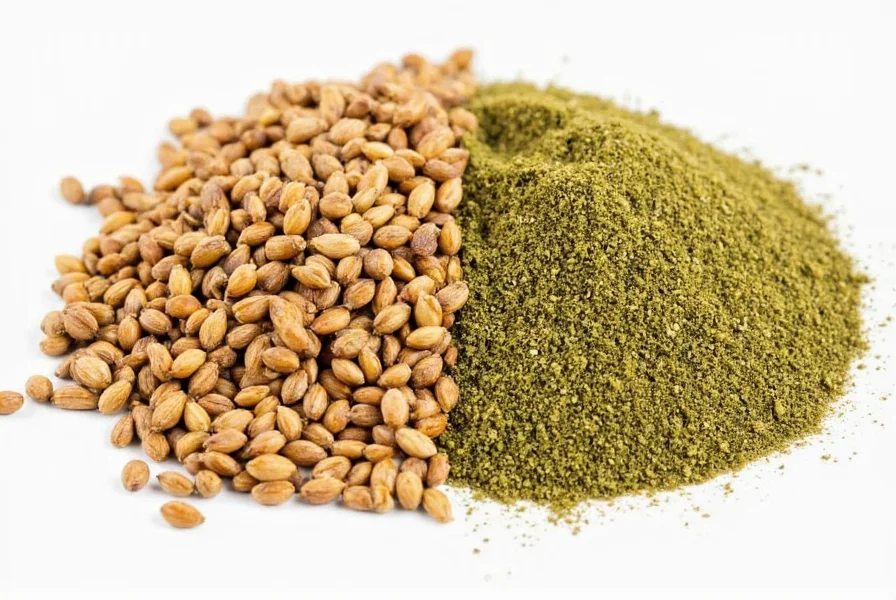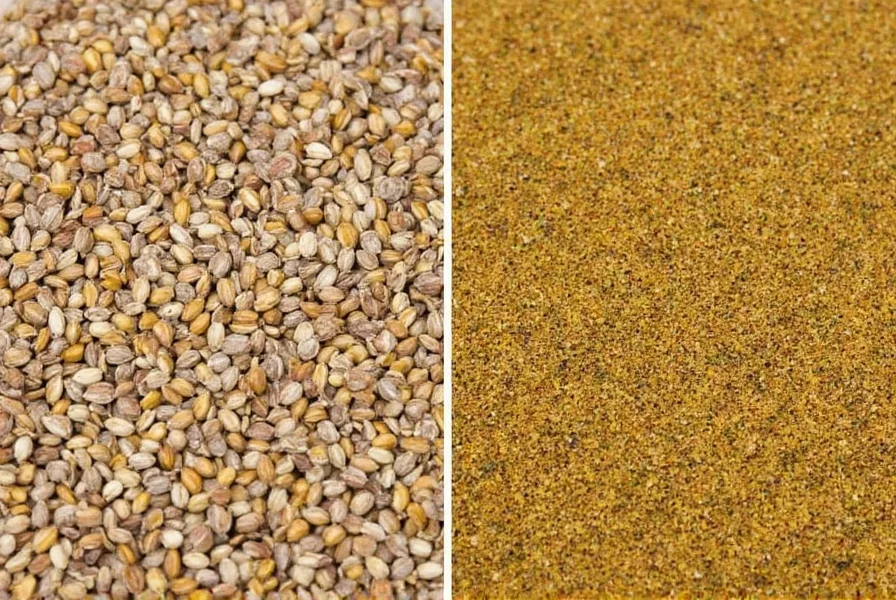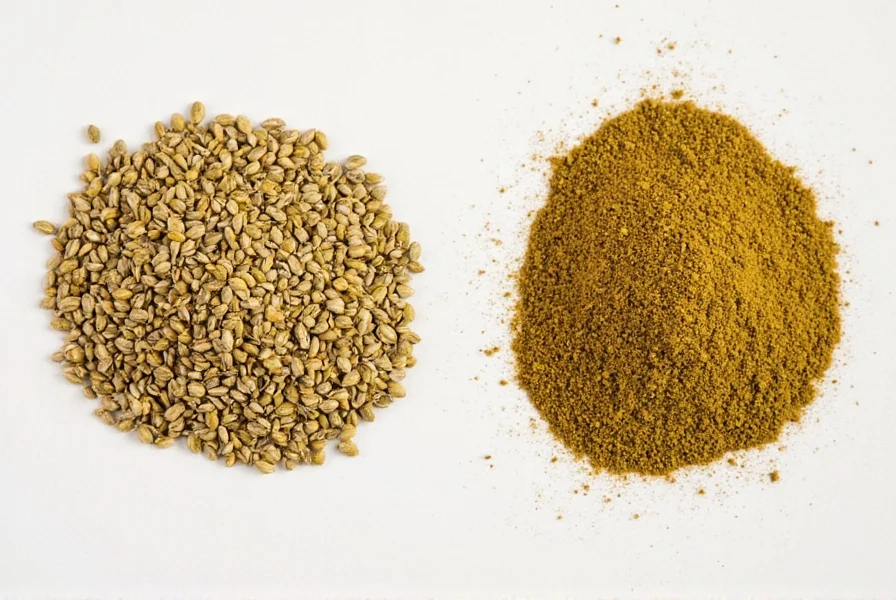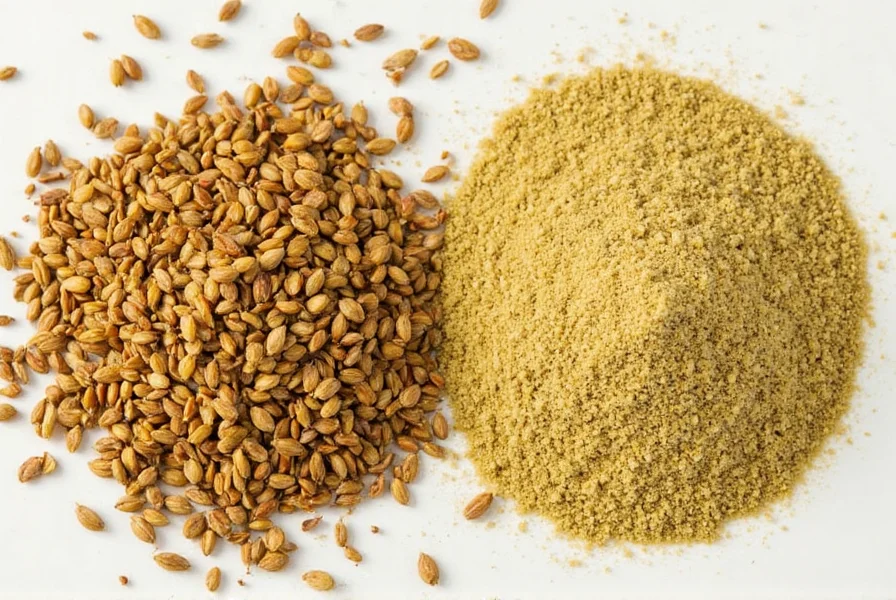Coriander seeds and ground coriander come from the same plant (Coriandrum sativum), but they have distinct flavors, uses, and storage requirements. Whole coriander seeds are ideal for toasting and adding texture to dishes like curries and pickles, while ground coriander provides immediate flavor and is perfect for spice rubs and sauces. Here's a detailed comparison:
| Feature | Coriander Seeds | Ground Coriander |
|---|---|---|
| Flavor Intensity | Mild when raw, develops depth when toasted | More immediate aroma, slightly stronger |
| Texture | Rough, whole, chewable | Powdery, smooth |
| Shelf Life | Lasts up to 4 years if stored properly | Loses potency faster (~6–12 months) |
| Best For | Toasting, pickling, braises, curry blends | Dry rubs, spice mixes, soups, sauces |
| Aroma | Citrusy, sweet, woody | Earthy, warm, floral |
Flavor Profile Breakdown
- Coriander Seeds: When raw, they have a grassy edge. Toast them and you unlock warm, bready, and lemony notes. Perfect for building deep backdrops in curries and stews.
- Ground Coriander: Offers instant fragrance and flavor. It's more versatile in dry rubs and spice mixes because it blends easily and evenly into recipes without needing extra grinding.
Top 5 Cooking Tips for Using Coriander Seeds and Ground Coriander
Ready to spice things up? Here are some pro tips to make the most of each form:
- Toasting Makes Magic: Always toast coriander seeds in a dry pan before using them. This intensifies their natural oils and unlocks a deeper, more complex flavor. Just don't walk away—you can go from perfectly golden to bitter in seconds!
- Whole Seeds in Pickles: Add whole coriander seeds to homemade pickled vegetables. They infuse brines with a gentle warmth that complements vinegar beautifully.
- Use Ground for Rubs: Mix ground coriander into spice rubs for meats like chicken, lamb, or pork. It pairs well with cumin, paprika, garlic powder, and turmeric.
- Add Late to Dishes: Ground coriander is delicate—add it toward the end of cooking to preserve its flavor, especially in sauces or soups.
- Make Your Own Powder: For maximum freshness, grind your own coriander powder at home using a spice grinder or mortar and pestle. Store only what you need for the next few weeks; the rest can be kept as whole seeds for longevity.

Buying Guide: Choosing the Best Coriander for Your Kitchen
Whether you're grabbing coriander seeds or pre-ground coriander off the shelf, not all products are created equal. Here's how to spot quality and freshness:
For Coriander Seeds
- Look for Whole, Unbroken Seeds: Avoid seeds that look cracked or split—they may be old or improperly dried.
- Fragrance Test: Fresh coriander seeds should smell faintly citrusy and herbal. If they're dull or musty, move on.
- Packaging: Choose seeds in airtight containers or vacuum-sealed bags. Exposure to air degrades quality quickly.
For Ground Coriander
- Color Check: Good-quality ground coriander has a light tan to beige color. Darker tones could mean age or poor storage conditions.
- Freshness Matters: Buy small quantities unless you use it often. Its potency drops significantly after 6 months.
- Brand Consideration: Stick with reputable spice brands known for purity and no additives (like Morton & Bassett, Simply Organic, or Frontier Co-op).
Top Picks for Quality Coriander Products
Here are our top recommendations based on performance, flavor, and customer reviews:
Morton & Bassett Whole Coriander Seeds
- Features: High oil content, rich aroma, organic options available
- Advantages: Ideal for roasting and long-cooked dishes
- Use Cases: Curries, pickles, homemade garam masala
- Target Audience: Home cooks and professional chefs alike
- Best For: Those who want bold, authentic spice layers

Simply Organic Ground Coriander
- Features: Certified organic, fine texture, quick aroma release
- Advantages: Easy to integrate into spice blends and sauces
- Use Cases: Dry rubs, baked goods, marinades
- Target Audience: Everyday cooks seeking convenience
- Best For: Quick meals and baking projects
Frontier Co-op Whole Coriander Seeds
- Features: Bulk option, sustainably sourced, fair trade certified
- Advantages: Economical for high-use kitchens
- Use Cases: Commercial cooking, spice blending, DIY recipes
- Target Audience: Chefs and avid home spice mixers
- Best For: Custom spice blends and bulk usage
Frequently Asked Questions About Coriander Seeds vs Ground Coriander
- Can I substitute ground coriander for coriander seeds (or vice versa) in recipes? Yes, but with some considerations. As a general rule, 1 teaspoon of ground coriander equals about 1.5 teaspoons of whole coriander seeds (since grinding concentrates the flavor). When substituting seeds for ground, you'll need to toast and grind them first. For the best flavor, we recommend using the form specified in the recipe, as they behave differently in cooking.
- Does toasting coriander seeds really make a difference? Absolutely! Toasting coriander seeds in a dry pan for 1-2 minutes dramatically enhances their flavor, releasing warm, citrusy, and nutty notes that raw seeds lack. This simple step can transform an average dish into something exceptional. Just be careful not to burn them—they go from perfectly toasted to bitter very quickly.
- Why does my ground coriander lose flavor so quickly? Ground spices have more surface area exposed to air, light, and moisture, which causes them to lose potency much faster than whole seeds. While whole coriander seeds can stay fresh for up to 4 years when stored properly, ground coriander typically maintains peak flavor for only 6-12 months. For maximum freshness, buy whole seeds and grind them as needed.
- What's the best way to store coriander to maintain freshness? Store whole coriander seeds in an airtight container in a cool, dark place. Glass jars with tight-fitting lids work well. Properly stored, they'll retain flavor for up to 4 years. For ground coriander, use small quantities, keep it in an opaque container away from light, and replace it every 6-12 months. Never store spices above the stove or near heat sources.
- Can I use cilantro leaves instead of coriander seeds? No, cilantro leaves and coriander seeds come from the same plant but have completely different flavor profiles. Cilantro leaves are fresh, citrusy, and divisive (some people perceive them as soapy), while coriander seeds are warm, earthy, and nutty. They're not interchangeable in recipes. If you need coriander seed flavor but only have cilantro leaves, you'll need to find a substitute like cumin or caraway, though the flavor won't be identical.
- Which is healthier—coriander seeds or ground coriander? Nutritionally, they're virtually identical since they're the same substance in different forms. Both contain antioxidants, fiber, and various vitamins and minerals. The main difference is that freshly ground coriander may have slightly higher nutrient availability since the grinding process releases more of the compounds. However, the health differences are minimal compared to the flavor and shelf life considerations.
Conclusion: Coriander Seeds vs Ground Coriander – Which to Choose?
In the comparison of coriander seeds versus ground coriander, the choice depends entirely on your cooking needs. Whole seeds offer superior longevity and develop deeper flavors when toasted, making them ideal for long-cooked dishes and pickling. Ground coriander provides immediate flavor and convenience for quick recipes and spice blends.

For optimal results: store whole seeds for long-term use and grind them fresh when needed, while keeping a small supply of ground coriander for quick meal preparation. This dual approach ensures you always have the right form for any recipe.











 浙公网安备
33010002000092号
浙公网安备
33010002000092号 浙B2-20120091-4
浙B2-20120091-4